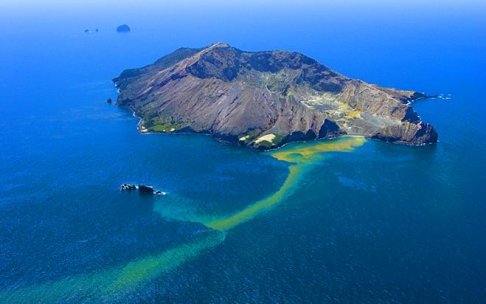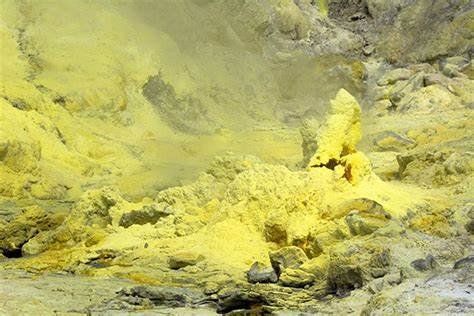Neil Oliver, a Scottish TV presenter, included White Island in New Zealand's Bay of Plenty, on his Coast NZ series, filmed in 2016. The island, which is actually an active, live volcano rising from shallow coastal waters near the coastal town of Whakatane, was named White Island by Captain Cook, who viewed it in 1769 on his southern explorations, because of its endless clouds of steam.
Neil Oliver said: "We had to land by helicopter and it's a great steaming, sulphurous live volcano. There was a constant sound of roaring, it's in the process of making, of being a volcano and it felt a faintly terrifying place to be because it could, of course, go big. We had gas masks around our necks so we could quickly put them on if the thing decided to do something."
The Maori name for the volcanic island, which obviously pre-dates Captain Cook, is te puia whakaari, meaning "The Dramatic Volcano".
Given that the nature of this place has been recognised in its naming by both indigenous and western visitors to the region over many hundreds of years, shouldn't this have been a flag to adventure tourism companies that this place may be a place to avoid? New Zealand offers many other adventurous experiences, so this could have easily been left off the repertoire.
Look at the landscape here - that is bright yellow sulphurous emissions, coating the rocks and also leaching into the near waters around the island. This natural form of pollution makes diving in the area dangerous - it is not only the dramatic volcanic landscape that promises that adrenalin rush. We are in the aftermath of a natural disaster where many people (tourists and tour guides) lost their lives, because it did "go big", erupting on Monday, 9th December. At the time of the eruption, around 2pm, a tourist boat was visiting the island, a day trip from an ocean cruise, The Ovation of the Seas, which was berthed at Tauranga on New Zealand's North Island. Those intrepid hikers and just ordinary people who wanted to record their "moment" on an active volcano, died needlessly because the risks weren't assessed accurately. The emergency rating (low is 1 and high is 5) had recently been upgraded to a 2. Not the peak of the warning, but volcanoes are unpredictable.
People who visit Spaceweather.com and other cosmic weather sites know that we are in a Maunder Minimum, and volcanic activity increases at that part of the sun's cycle (hopefully the CMEs get less, but the volcanoes and earthquakes (and possible subsequent tsunamis) have an uptick. Perhaps the tourist company, or at least the New Zealand government, could have been better informed.





May all associated with this tragedy find peace with the decisions that led a tour boat to be visiting the volcano at that fateful time.
Neil Oliver said: "We had to land by helicopter and it's a great steaming, sulphurous live volcano. There was a constant sound of roaring, it's in the process of making, of being a volcano and it felt a faintly terrifying place to be because it could, of course, go big. We had gas masks around our necks so we could quickly put them on if the thing decided to do something."
The Maori name for the volcanic island, which obviously pre-dates Captain Cook, is te puia whakaari, meaning "The Dramatic Volcano".
Given that the nature of this place has been recognised in its naming by both indigenous and western visitors to the region over many hundreds of years, shouldn't this have been a flag to adventure tourism companies that this place may be a place to avoid? New Zealand offers many other adventurous experiences, so this could have easily been left off the repertoire.
Look at the landscape here - that is bright yellow sulphurous emissions, coating the rocks and also leaching into the near waters around the island. This natural form of pollution makes diving in the area dangerous - it is not only the dramatic volcanic landscape that promises that adrenalin rush. We are in the aftermath of a natural disaster where many people (tourists and tour guides) lost their lives, because it did "go big", erupting on Monday, 9th December. At the time of the eruption, around 2pm, a tourist boat was visiting the island, a day trip from an ocean cruise, The Ovation of the Seas, which was berthed at Tauranga on New Zealand's North Island. Those intrepid hikers and just ordinary people who wanted to record their "moment" on an active volcano, died needlessly because the risks weren't assessed accurately. The emergency rating (low is 1 and high is 5) had recently been upgraded to a 2. Not the peak of the warning, but volcanoes are unpredictable.
People who visit Spaceweather.com and other cosmic weather sites know that we are in a Maunder Minimum, and volcanic activity increases at that part of the sun's cycle (hopefully the CMEs get less, but the volcanoes and earthquakes (and possible subsequent tsunamis) have an uptick. Perhaps the tourist company, or at least the New Zealand government, could have been better informed.





May all associated with this tragedy find peace with the decisions that led a tour boat to be visiting the volcano at that fateful time.
Last edited:









